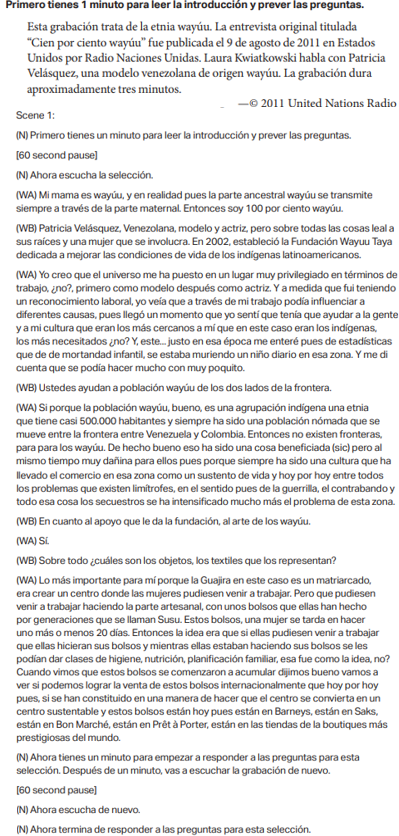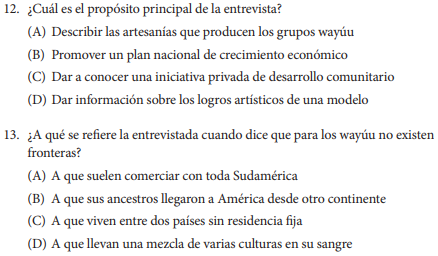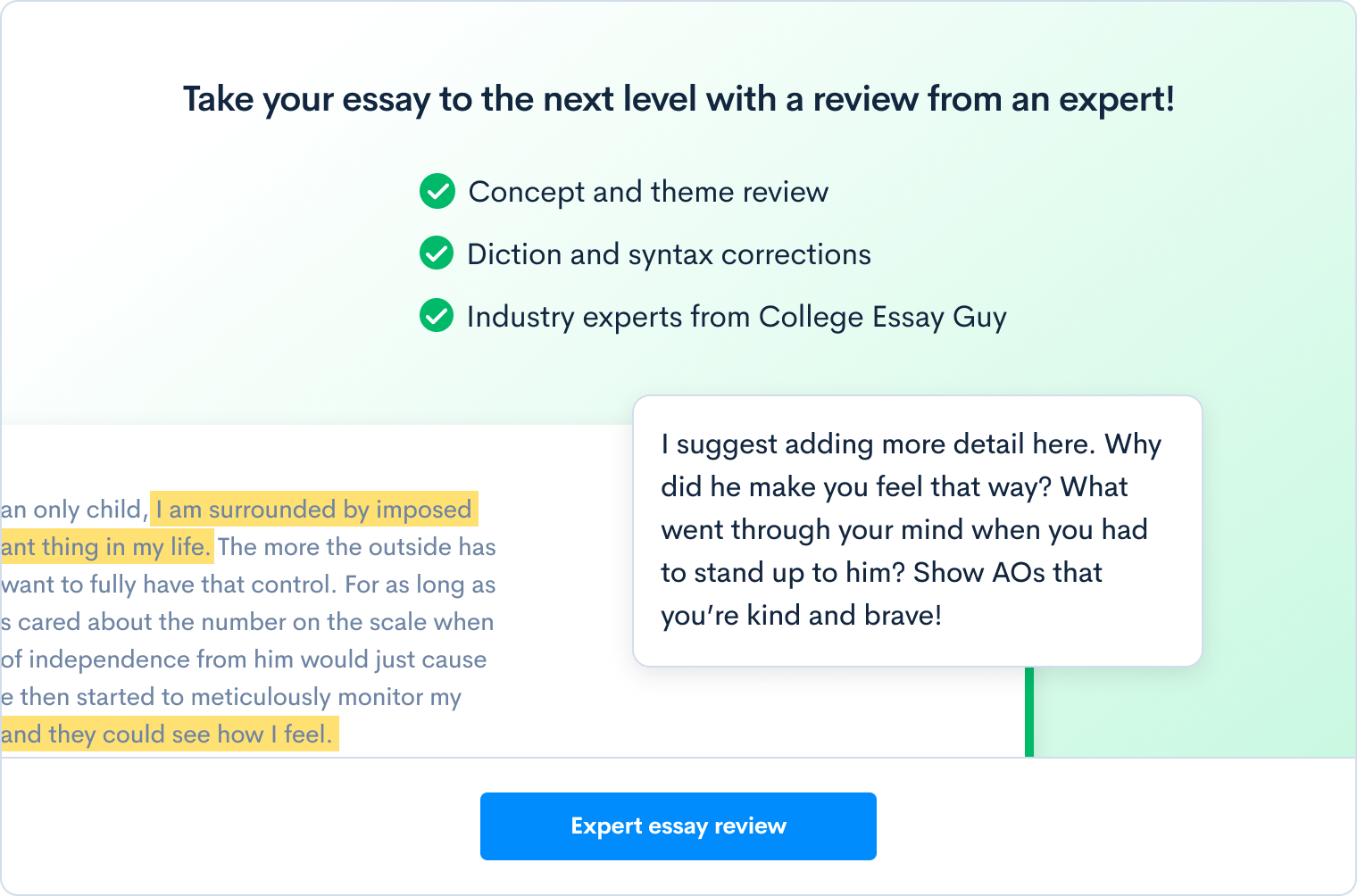Ultimate Guide to the AP Spanish Language and Culture Exam
The AP Spanish courses are the most popular AP foreign language classes. In fact, they’re so popular that two sets of Spanish curricula exist: AP Spanish Language and Culture and AP Spanish Literature and Culture. This is the only AP foreign language that has more than one course offering. In 2019, over 185,000 students took the AP Spanish Language and Culture exam, making it by far the most popular foreign language exam taken. The curriculum for the AP Spanish Language and Culture exam emphasizes communication by applying interpersonal, interpretive, and presentational skills in real-life situations. As you undertake the coursework or exam preparations, you will need to focus on understanding others and being understood by others. If you’re planning to take the AP Spanish Language and Culture exam, whether you have taken the class, are a native speaker, or have self-studied, read on for a breakdown of the test and CollegeVine’s advice for how to best prepare. The College Board will administer the 2020 AP Spanish Language and Culture exam on Tuesday, May 12, at 8 am. For a complete list of all the AP exams, along with tips for success and information about how students score, check out our article 2020 AP Exam Schedule: Everything You Need to Know. The AP Spanish Language and Culture course is taught almost exclusively in Spanish and includes instruction in vocabulary usage, language control, communication strategies, and cultural awareness. Although there is some emphasis placed on correct grammar usage, the College Board specifically warns against overemphasizing grammatical accuracy at the expense of communication. Instead, more time will be spent on applying interpersonal, interpretive, and presentational communication skills in real-life situations, exploring the culture in both contemporary and historical contexts, and building an awareness and appreciation of cultural products, practices, and perspectives. There are no explicit prerequisites for the AP Spanish Language and Culture course, but students who take it are typically in their fourth year of high school-level Spanish language study or have extensive practical experience communicating in both written and oral Spanish language. There are four essential components to the framework of the AP Spanish Language and Culture course that clarify what you must know, be able to do, and understand to qualify for college credit or placement. Those components are skills, themes, modes, and task models. Skills: Skills are the abilities you’ll need to think and act like a Spanish speaker. The College Board breaks these skills into eight units; below is a list of those units along with the weight they are given on the multiple-choice section of the AP Spanish Language and Culture exam: multiple-choice section. multiple-choice section. multiple-choice section. multiple-choice section. Themes: The AP Spanish Language and Culture course is divided into 6 themes in which there are 5-7 contexts covered. Below are the 6 themes along with their recommended contexts: Modes: To pass the AP Spanish Language and Culture exam, students need to demonstrate proficiency engaging in three modes of communication: interpretive, interpersonal, and presentational. Students need to possess skills in listening, reading, speaking, and writing in the following areas: Task Model: Finally, you will work with various task models to demonstrate linguistic skills and cultural understanding. The task model types are: At 3 hours and 3 minutes long, the AP Spanish Language and Culture exam is one of the longer-lasting AP exams. It consists of two primary sections—the first section featuring multiple-choice questions, and the second made up of free response questions. The multiple-choice questions are further broken down into two parts—one part based on text as a stimulus, the other part uses audio as a stimulus. Section 1(a): Multiple-Choice Text 40 minutes | 30 questions | 23% of score The first part of the AP Spanish Language and Culture exam uses a variety of printed materials—journalistic and literary texts, announcements, advertisements, letters, charts, maps, and tables—as a stimulus. You’re asked to identify ideas and details, define words in context, identify an author’s point of view or target audience, and demonstrate knowledge of cultural or interdisciplinary information contained in the text. Example of a text-based multiple-choice question: Answers to multiple-choice questions above: Section 1(b): Multiple-Choice Audio 55 minutes | 35 questions | 27% of score The second part of the multiple-choice section uses audio material—interviews, podcasts, PSAs, conversations, and brief presentations—as a stimulus. In this part of the exam, students will encounter two subsections of questions. Example of a question you’ll encounter in the audio-based multiple-choice section, click on the question for audio: Answers to the multiple choice questions above: The free-response section of the AP Spanish Language and Culture exam is also broken down into two parts—one part focusing on writing, and the other on speaking. Section 2 (a): Free Response Written 1 hour 10 minutes | 2 questions | 25% of score The first free response section features two questions—one on interpersonal writing and the other on presentational writing. The first of the two questions require you to read and respond to an email. You have 15 minutes to complete this section, and it’s worth 12.5% of your exam score. The second of these questions provides three sources—including an article, a table, graph, chart, or infographic, and a related audio source offering different viewpoints on a topic—that you will use to construct an argumentative essay. This question is allotted 55 minutes (15 minutes to review materials and 40 minutes to write) and is also worth 12.5% of your exam score. Example of an email free-response question: Section 2: Free Response Spoken 18 minutes | 2 questions | 25% of score The spoken part of the free response section tests your interpersonal and presentational speaking ability. For interpersonal speaking, you will participate in five exchanges in a simulated conversation with 20 seconds for each response. For the second part, you’re tasked with delivering a two-minute presentation requiring you to compare a cultural feature of a Spanish-speaking community to another community you are familiar with. When delivering oral responses, you will be digitally recorded and your proctor will submit your recordings with the rest of your test materials. Learn more about submitting audio on the College Board’s webpage of the same name, Submitting Audio. Example of a spoken, presentational, free-response question: In 2019, students generally did quite well on the AP Spanish Language and Culture exam. More than half of all students received a score of 4 or 5, and nearly 90% of test-takers received a passing score (3 or higher). Though students who regularly spoke or heard Spanish outside of school did perform slightly better overall than the standard group of foreign language students, the standard group still passed the exam at a rate of nearly 85% and only 3% received the lowest score of a 1. To guide your studying, read the full AP Spanish course description. For a comprehensive listing of the score distribution on all of the AP exams, check out our post Easiest and Hardest AP Exams. It’s important to start your studying off with a good understanding of your existing knowledge. Although the College Board does not provide a complete practice test, you can find sample questions with scoring explanations included in the course description. Additionally, you can find a free AP Spanish Language and Culture diagnostic test from Varsity Tutors. You may also find practice or diagnostic exams in many of the commercially printed study guides. In the case of the AP Spanish Language and Culture course, the theory you’ll need to know falls into six themes (Beauty and Aesthetics, Contemporary Life, Families and Communities, Global Challenges, Personal and Public Identities, Science and Technology). Many textbooks will be divided into units based on these themes. Even if they are not, you should find threads of them throughout your studies. Of course, the best way to study a foreign language is to truly immerse yourself in it. Although your course will be taught primarily in Spanish, this will account for only a tiny percentage of your day. You should find other ways to further your exposure to the Spanish language, and given the prevalence of Spanish in our own contemporary culture, this should not be difficult. You can easily find engaging young adult books written in Spanish, interesting Youtube videos or TV shows in Spanish, or even Spanish podcasts. Check out comic books, news, or websites in Spanish. Make sure you are speaking, listening to, and reading Spanish as much as possible, even outside of your regular study or class hours. The College Board also provides some valuable study tools for your use. Reviewing the AP Spanish Language and Culture Course and Exam Description can help you to more deeply understand the course content and format. You should also review the exam audio files and the official Exam Practice Tips to help guide your studying. In addition, you should take advantage of the many commercial study guides available for your use. One of the top-rated AP Spanish Language and Culture study guides is the Princeton Review’s Cracking the AP Spanish Language & Culture Exam with Audio CD, 2020 Edition. This compilation of content reviews and strategies also contains two full-length practice tests with complete answer explanations and access to the Princeton Review’s AP Connect portal online. Another great option is Barron’s AP Spanish Language and Culture with MP3 CD, 8th Edition, which again contains two full-length practice exams with audio sections for both practice exams. There are also vast amounts of study materials available online. Taking one of the more popular AP exams means that many students have been in your shoes, and often they or their teachers have posted past materials to supplement their studying. You can find a huge database of resources including sound files, Spanish reading sites, and grammar sites—this site is a good place to get started. Finally, apps are a relatively new and fun way to squeeze in a little more studying. The Fluent U app is a great option for AP foreign languages. The basic version is free, but watch out for in-app purchases. The premium versions can set you back between $30 and $240 dollars. Once you’ve got a good handle on the major course content and theory, you can begin putting it to use. Start by practicing multiple-choice questions. You will be able to find plenty of these available online (for example, study.com has a free 50-question online practice test) for the AP Spanish Language and Culture exam, or you can try the practice ones provided in commercial study guides. The College Board course description also contains a number of multiple-choice questions with answers and explanations. As you are reviewing these, keep track of which broad content areas are coming easily to you and which still require more effort. Think about what each question is really asking you to do, and keep a list of vocabulary, grammar, and content areas that still seem unfamiliar. These will be points for more review before you move on. Even if you’ve studied for the free response section of other APs in the past, your studies for the free response section of the foreign language AP exams will be quite different. In addition to practicing your written responses, you’ll also need to fine-tune your listening skills and oral responses. Begin your preparations by brushing up on your vocabulary and grammar. Make sure you have a handle on a broad variety of verbs and how to conjugate each. Also, reaffirm that your knowledge of vocabulary will allow you to express yourself as fluently as possible. A great tool for this is a supplementary set of Barron’s AP Spanish Flash Cards. These cards emphasize word usage within the context of sentences and review parts of speech, noun genders, verb forms and tenses, and correct sentence structure. Beyond vocabulary and grammar, your studies should also include practicing written and oral responses. The best way to specifically prepare for both the written and spoken portions of your free response questions is to practice repeated similar prompts. There is a huge resource of past free response questions available on College Board’s website dating back to 1999, with accompanying scoring explanations and examples of authentic student responses. To make the most of these example free response questions, review the Chief Reader Report on Student Responses wherein the Chief Reader of the AP Exam compiles feedback to describe how students performed on the prompts, summarizes typical student errors, and addresses specific concepts and content with which students have struggled the most. It can be especially difficult to prepare for the oral portion of your free response section since it’s difficult to identify your own spoken errors. Try recording your responses and comparing them to the authentic student responses available above. Alternatively, collaborate with a classmate to record and trade responses, offering one another constructive criticism framed by the scoring examples available above. Just as you took a practice test at the beginning of your preparations to gauge your readiness for the exam, do so again after a thorough review of the course content and each exam portion. Identify the areas in which you’ve improved the most, and areas still in need of improvement. If time allows, repeat the steps above to incrementally increase your score with each pass. If you’re taking the AP course associated with this exam, your teacher will walk you through how to register. If you’re self-studying, check out our blog post How to Self-Register for AP Exams. For information about what to bring to the exam, see our post What Should I Bring to My AP Exam (And What Should I Definitely Leave at Home)? Want access to expert college guidance — for free? When you create your free CollegeVine account, you will find out your real admissions chances, build a best-fit school list, learn how to improve your profile, and get your questions answered by experts and peers—all for free. Sign up for your CollegeVine account today to get a boost on your college journey. For more information about APs, check out these CollegeVine posts: When is the AP Spanish Language and Culture Exam?
About the AP Spanish Language and Culture Exam
Skill
Description
Percentage of Exam Score (Multiple-Choice Section)
Comprehend Text
Comprehend written, audio, audiovisual, and visual text (text, pictures, and numbers).
20%-30%
Make Connections
Make interdisciplinary and cultural connections.
30%-40%
Interpret Text
Interpret the content of written or audio text (words).
30%-40%
Make Meanings
Make meanings from words and expressions.
10%-15%
Speak to Others
Communicate interpersonally by speaking with others.
Not directly assessed in the
Write to Others
Communicate interpersonally by writing to others.
Not directly assessed in the
Present Orally
Communicate through spoken presentations.
Not directly assessed in the
Present in Writing
Communicate through written presentations.
Not directly assessed in the
Theme
Recommended Contexts
Families and Communities
Personal and Public Identities
Beauty and Aesthetics
Science and Technology
and Society
Contemporary Life
Global Challenges
Task Model
Mode
Promotional material
Interpretive—print source
Literary text
Interpretive—print source
Article and chart
Interpretive—print source
Letter
Interpretive—print source
Audio report and article
Interpretive—audio and print sources
Conversation and chart
Interpretive—audio and print sources
Interview
Interpretive—audio source
Instructions
Interpretive—audio source
Presentation
Interpretive—audio source
Email reply
Interpersonal—written
Argumentative essay
Interpersonal—written
Conversation
Interpersonal—spoken
Cultural comparison
Interpersonal—spoken
AP Spanish Language and Culture Exam Content
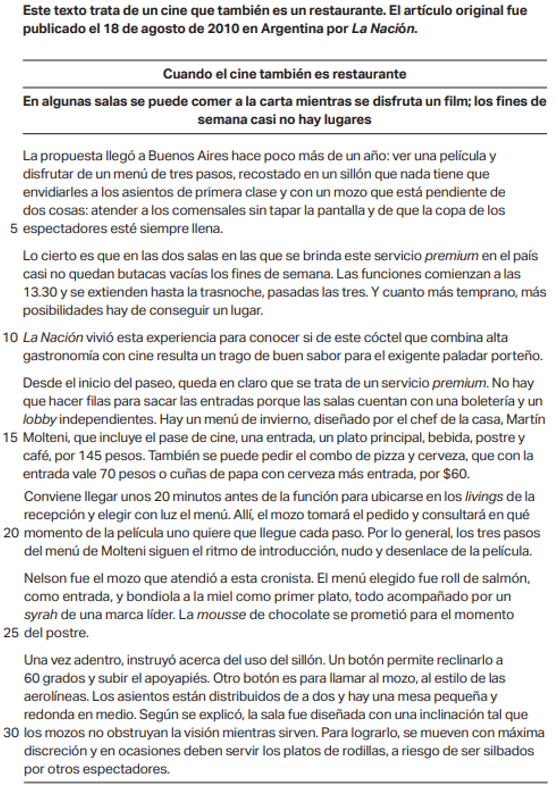
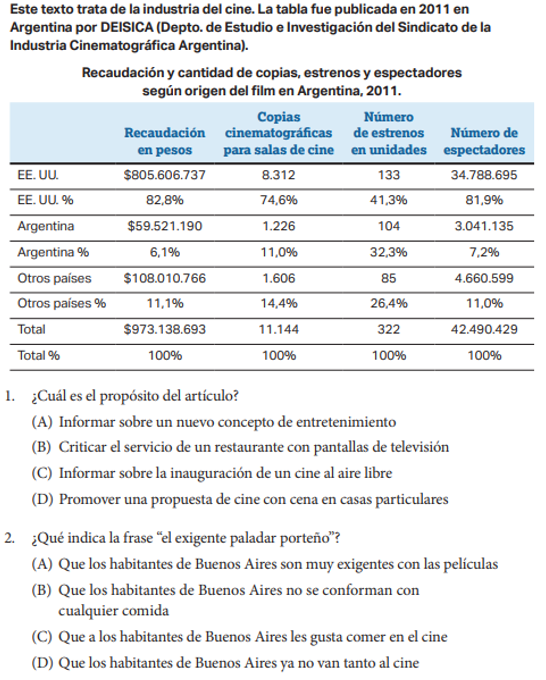
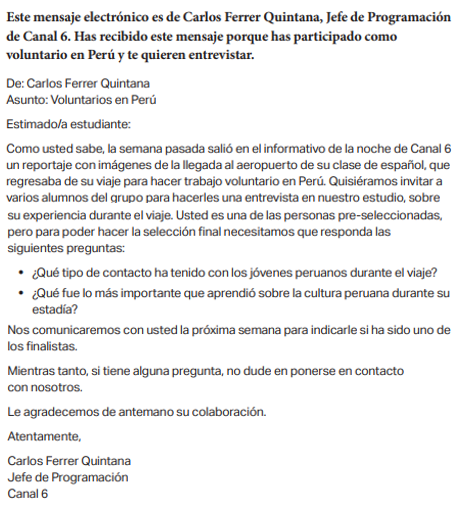
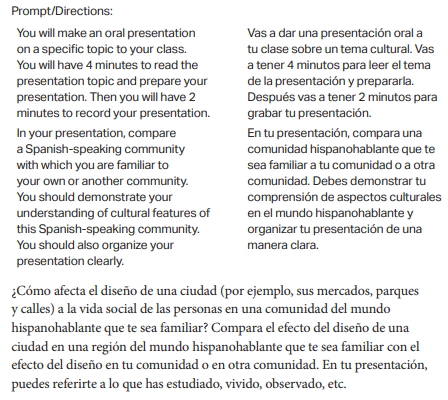
AP Spanish Language and Culture Score Distribution, Average Score, and Passing Rate
Exam
5
4
3
2
1
AP Spanish Language and Culture
25.2%
34.2%
29.4%
9.5%
1.8%
Best Ways to Study for the AP Spanish Language and Culture Exam
Step 1: Start by Assessing Your Skills
Step 2: Study the Material
Step 3: Practice Multiple-Choice Questions
Step 4: Practice Free Response Questions
Step 5: Take Another Practice Test
Step 6: Exam Day Specifics
